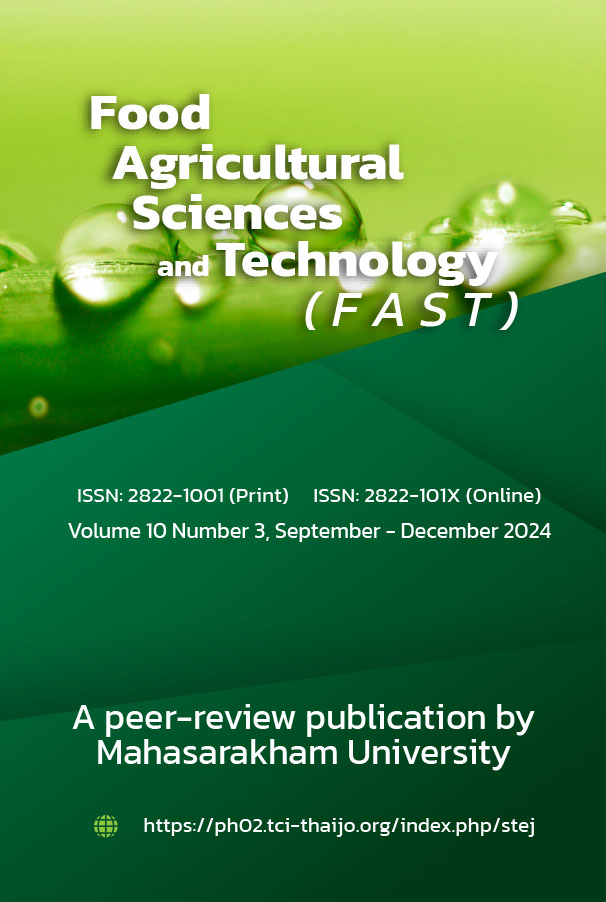Encapsulation of Trichoderma harzianum with sodium alginate and evaluation of efficacy against fungal plant pathogen
Keywords:
Biocontrol, Bioproduct, Encapsulation, Plant pathogen, Trichoderma harzianumAbstract
Plant pathogenic fungi pose signifcant agricultural challenges, potentially as the cause of crop damage and reduced yields. This study evaluated the effectiveness of bioproducts formulated by encapsulating Trichoderma harzianum spores with sodium alginate for controlling 3 plant pathogenic fungi: Fusarium sp., Curvularia sp., and Alternaria sp. The assessment employed the dual culture methods on a potato dextrose agar (PDA) medium. The research revealed that this bioproduct’s wet and dry forms, stored at different temperatures (4 °C and 28±2 °C), could maintain their spherical, uniform, and green appearances. Spore counts and spore survival for wet and dry forms stored at 4 °C were 2.53×106, 1.01×106 and 1.31×106, 1.10×105 spores/ ml, respectively. Spore counts and spore survival for those stored at 28±2 °C were 3.18×106, 1.11×106 and 1.29×106, 1.00×105 spores/ml, respectively. Regarding the control of pathogenic fungi growth, both wet and dry forms stored at 4 °C exhibited inhibition percentages ranging from 64.10% to 82.35% and 64.74% to 81.25%, respectively. Similarly, those stored at 28±2 °C were shown to have inhibition percentages ranging from 65.38% to 84.31% and 66.66% to 86.27%, respectively. Statistically signifcant differences (p<0.05) were observed in the inhibition rates of all 3 pathogenic fungi between the two forms of bioproducts stored at different temperatures.
References
Abbas, A., Mubeen, M., Zheng, H., Sohail, M. A., Shakeel, Q., Solanki, M. K., Iftikhar, Y., Sharma, S., Kashyap, B. K., & Hussain, S. (2022). Trichoderma spp. genes involved in the biocontrol activity against Rhizoctonia solani. Frontiers in Microbiology, 13, 884469. https://doi.org/10.3389/fmicb.2022.884469
Adnan, M., Islam, W., Shabbir, A., Khan, K. A., Ghramh, H. A., Huang, Z., Chen, H. Y., & Lu, G.-d. (2019). Plant defense against fungal pathogens by antagonistic fungi with Trichoderma in focus. Microbial Pathogenesis, 129, 7-18. https://doi.org/10.1016/j.micpath.2019.01.042
Asad, S. A. (2022). Mechanisms of action and biocontrol potential of Trichoderma against fungal plant diseases—A review. Ecological Complexity, 49, 100978. https://doi.org/10.1016/j.ecocom.2021.100978
Fraceto, L. F., Maruyama, C. R., Guilger, M., Mishra, S., Keswani, C., Singh, H. B., & de Lima, R. (2018). Trichoderma harzianum-based novel formulations: Potential applications for management of next-gen agricultural challenges. Journal of Chemical Technology & Biotechnology, 93(8), 2056-2063. https://doi.org/10.1002/jctb.5613
Gamliel, A., Katan, J., & Cohen, E. (1989). Toxicity of chloronitrobenzenes to Fusarium oxysporum and Rhizoctonia solani as related to their structure. Phytoparasitica, 17(2), 101-106. https://doi.org/10.1007/BF02979517
Gupta, V., & Sharma, A. K. (2013). Assessment of optimum temperature of Trichoderma harzianum by monitoring radial growth and population dynamics in different compost manures under different temperatures. Octa Journal of Biosciences, 1(2).
Kawicha, P., Natino, W., Phatthanasan, W., & Sangdee, A. (2020). Development of granular Trichoderma bioproducts for controlling yellow wilt disease of tomatoes. Thai Journal of Science and Technology, 9(6), 832-843.
Locatelli, G. O., dos Santos, G. F., Botelho, P. S., Finkler, C. L. L., & Bueno, L. A. (2018). Development of Trichoderma sp. formulations in encapsulated granules (CG) and evaluation of conidia shelf-life. Biological Control, 117, 21-29. https://doi.org/10.1016/j.biocontrol.2017.08.020
Mancera-López, M. E., Izquierdo-Estévez, W. F., Escalante-Sánchez, A., Ibarra, J. E., & Barrera-Cortés, J. (2019). Encapsulation of Trichoderma harzianum conidia as a method of conidia preservation at room temperature and propagation in submerged culture. Biocontrol Science and Technology, 29(2), 107-130. https://doi.org/10.1080/09583157.2018.1535053
Maruyama, C. R., Bilesky-José, N., de Lima, R., & Fraceto, L. F. (2020). Encapsulation of Trichoderma harzianum preserves enzymatic activity and enhances the potential for biological control. Frontiers in Bioengineering and Biotechnology, 8, 225. https://doi.org/10.3389/fbioe.2020.00225
Mbarga, J. B., Ten Hoopen, G. M., Kuaté, J., Adiobo, A., Ngonkeu, M., Ambang, Z., Akoa, A., Tondje, P. R., & Begoude, B. (2012). Trichoderma asperellum: A potential biocontrol agent for Pythium myriotylum, causal agent of cocoyam (Xanthosoma sagittifolium) root rot disease in Cameroon. Crop Protection, 36, 18-22. https://doi.org/10.1016/j.cropro.2012.02.004
Mohd Anuar, I., Ku Sulong, K., Abdul Ghani, H., & Wahab, M. (2020). Alginate encapsulation of Trichoderma harzianum against brown spot disease on rice (Oryza sativa) in vivo assays. Food Research, 4(5), 138-141.
Qi, Q., Fan, C., Wu, H., Sun, L., & Cao, C. (2023). Preparation of Trichoderma asperellum microcapsules and biocontrol of cucumber powdery mildew. Microbiology Spectrum, e05084-22. https://doi.org/10.1128/spectrum.05084-22
Santamarina, M. P., & Rosello, J. (2006). Influence of temperature and water activity on the antagonism of Trichoderma harzianum to Verticillium and Rhizoctonia. Crop Protection, 25(10), 1130-1134. https://doi.org/10.1016/j.cropro.2006.02.006
Sellitto, V. M., Zara, S., Fracchetti, F., Capozzi, V., & Nardi, T. (2021). Microbial biocontrol as an alternative to synthetic fungicides: Boundaries between pre- and postharvest applications on vegetables and fruits. Fermentation, 7(2), 60. https://doi.org/10.3390/fermentation7020060
Siddiquee, S., Yusuf, U. K., Hossain, K., & Jahan, S. (2009). In vitro studies on the potential Trichoderma harzianum for antagonistic properties against Ganoderma boninense. Journal of Food, Agriculture and Environment, 7(3 & 4), 970-976.
Zafra, G., & Cortés-Espinosa, D. V. (2015). Biodegradation of polycyclic aromatic hydrocarbons by Trichoderma species: A mini review. Environmental Science and Pollution Research, 22(24), 19426-19433. https://doi.org/10.1007/s11356-015-5602-4
Zeilinger, S., Gruber, S., Bansal, R., & Mukherjee, P. K. (2016). Secondary metabolism in Trichoderma—Chemistry meets genomics. Fungal Biology Reviews, 30(2), 74-90. https://doi.org/10.1016/j.fbr.2016.05.001
Downloads
Published
How to Cite
Issue
Section
License
Copyright (c) 2024 Food Agricultural Sciences and Technology

This work is licensed under a Creative Commons Attribution-NoDerivatives 4.0 International License.








